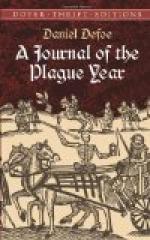Though the health of the city was now very much restored, yet foreign trade did not begin to stir; neither would foreigners admit our ships into their ports for a great while. As for the Dutch, the misunderstandings between our court and them had broken out into a war the year before, so that our trade that way was wholly interrupted; but Spain and Portugal, Italy and Barbary,[315] as also Hamburg, and all the ports in the Baltic,—these were all shy of us a great while, and would not restore trade with us for many months.
The distemper sweeping away such multitudes, as I have observed, many if not all of the outparishes were obliged to make new burying grounds, besides that I have mentioned in Bunhill Fields, some of which were continued, and remain in use to this day; but others were left off, and, which I confess I mention with some reflection,[316] being converted into other uses, or built upon afterwards, the dead bodies were disturbed, abused, dug up again, some even before the flesh of them was perished from the bones, and removed like dung or rubbish to other places. Some of those which came within the reach of my observations are as follows:—
First, A piece of ground beyond Goswell Street, near Mountmill, being some of the remains of the old lines or fortifications of the city, where abundance were buried promiscuously from the parishes of Aldersgate, Clerkenwell, and even out of the city. This ground, as I take it, was since[317] made a physic garden,[318] and, after[319] that, has been built upon.
Second, A piece of ground just over the Black Ditch, as it was then called, at the end of Holloway Lane, in Shoreditch Parish. It has been since made a yard for keeping hogs and for other ordinary uses, but is quite out of use as a burying ground.
Third, The upper end of Hand Alley, in Bishopsgate Street, which was then a green field, and was taken in particularly for Bishopsgate Parish, though many of the carts out of the city brought their dead thither also, particularly out of the parish of St. Allhallows-on-the-Wall. This place I cannot mention without much regret. It was, as I remember, about two or three years after the plague was ceased, that Sir Robert Clayton[320] came to be possessed of the ground. It was reported, how true I know not, that it fell to the King for want of heirs (all those who had any right to it being carried off by the pestilence), and that Sir Robert Clayton obtained a grant of it from King Charles II. But however he came by it, certain it is the ground was let out to build on, or built upon by his order. The first house built upon it was a large fair house, still standing, which faces the street or way now called Hand Alley, which, though called an alley, is as wide as a street. The houses in the same row with that house northward are built on the very same ground where the poor people were buried; and the bodies, on opening the ground for the foundations,




